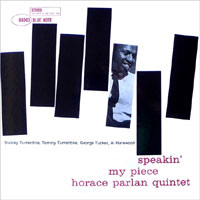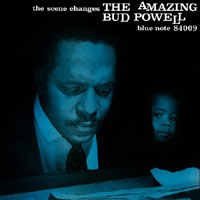Horace Parlan Quintet • Speakin' My Piece
Bud Powell • The Scene Changes
hat needs to be said about the reissue of a landmark album by one of modern jazz’s most important -- albeit troubled -- pianists and composers? Not much, other than that Music Matters has once again knocked the ball out of the park with its selection of material and customary attention to detail. Earl "Bud" Powell, born in Harlem in 1924, is generally considered one of the most important pianists in jazz history and the father of modern jazz piano. Befriended by Thelonious Monk, who became his mentor, and heavily influenced by Art Tatum, he made his first recordings when he was in his 20s. His last came just two decades later; he died, sadly, at age 44 of tuberculosis, malnutrition and alcoholism. In between incarcerations and hospitalizations, Powell worked with some of the most important and famous jazz musicians of the day, including Charlie Parker, Dizzy Gillespie, Miles Davis and Sonny Rollins. His solo, trio and group recordings on the Clef, Norgran, Verve and Blue Note labels are considered by many to be among the finest and most influential in all of jazz. If not bursting with the fire and excitement of Powell's early Norman Granz-produced recordings, the relaxed tunes on The Scene Changes certainly stand the test of time. To call the first of the album’s nine Powell originals, "Cleopatra’s Dream," amazing would be an understatement. It is the quintessential piano-trio performance. All hands are on deck for this one, and it swings unmercifully. "Duid Deed" continues the journey into jazz with an idiomatic bop figure played to perfection by the trio. An up-tempo swinger, "Down With It" personifies what bebop style is all about. Chambers takes a short (thankfully) bowed solo and Taylor gets a chance to shine for a few minutes. "Danceland" is a jaunty tune propelled by the rock-solid beat laid down by Chambers and Taylor. Almost classical in its melody, "Borderick" is a nursery-rhyme ode to Powell’s son, pictured on the album’s cover peering over the pianist's left shoulder. "Crossin’ the Channel" opens side two as an up-tempo, linear swinger. "Comin’ Up" begins with a six-note figure by Art Taylor and leads into a Latin-flavored tune that sounds oh-so-south-of-the-border. "Gettin’ There" returns to bop and Powell turns the figure into a relaxed groove with horizontal, horn-like phrasing. The album ends with the title song, based on a Parker-like theme in pure bop style, the perfect embodiment of a trio of musicians thinking as one. These late-1958 sessions were among the last Rudy Van Gelder recorded in the studio in his parent’s house in Hackensack, New Jersey. Such is the intimacy of the recording that Powell is clearly heard accompanying his piano runs with his energetic vocalizing. However, comparing the somewhat indistinct piano sound on this album to that of other Blue Notes, I can only guess that Van Gelder was not having a particularly good day capturing the instrument with his microphones. The music of Horace Parlan, an acquired taste for many, flows from the grooves of Speakin’ My Piece, the pianist's first album under his own name and employing horns. Born in Pittsburgh in 1931 and stricken with polio at age five, Parlan began piano lessons as therapy at age eight and overcame the debilitating effects of the disease by developing a very strong left hand and a fingering style in his right hand that fooled the listener into believing no disability existed. In interviews, Parlan cited Ahmad Jamal and Bud Powell as major influences, and his very personal style incorporates gospel influences along with elements of R&B and the blues. "Wadin," the album’s opener, is a slow, lazy blues with Stanley Turrentine’s tenor sax bathed in reverb for his energetic solo. His brother, Tommy, turns in a competent but uninspired solo laden with clunkers. "Up In Cynthia’s Room" is a smooth one -- the theme coasting along on a memorable note. Charging out of the gate, Turrentine once again lays down a fine tenor solo followed by his brother, who seems lost on his. Parlan serves up an angular solo rich in bop tradition and gospel undertones. Bassist George Tucker is featured in a brief solo. A trio version of this song recorded six months earlier strikes more at the heart of the bop tradition, and I find it preferable. "Borderline" features another good theme, penned by Stanley Turrentine, with the usual round of solos: Stanley on tenor, Tommy on trumpet and Parlan on piano (in a down-home romp). A double-stopped bass sets the mood on the Tommy Turrentine original
"Rastus." Immediately engaging, the tune demonstrates the agility of the players
with Stanley Turrentine turning in his best work on the album (ditto for Tommy). Parlan
contributes a hard-swinging, funky solo highlighted with strong backbeats from drummer Al
Harewood. Leon Mitchell, saxophonist and A&R man for Blue Note, contributed the next
song, "Oh So Blue," and it is a refreshing change of pace. His tenor awash in
reverb, Stanley Turrentine testifies -- perhaps to a long-lost love affair -- his
full-throated tone perfectly suited to this tune. Tommy’s obligatos tastefully fill
in the silences. Parlan follows with his most lyrical solo on the album. Closing out the
album, the title tune is a medium-tempo, easy swinger penned by Parlan. It is similar,
though prettier, to many we’ve heard before and idiomatic of the genre, with tasteful
solos all around. |



